How Does Sonication Affect Alpha Synuclein Preformed Fibrils?
StressMarq Biosciences generates a wide variety of alpha synuclein fibrillar and oligomeric constructs that can be used to develop disease models for neurodegeneration research. For best results, fibrils need to be sonicated prior to use. Studies have shown that sonication reduces fibril size, which is critical in seeding pathology in vitro and in vivo1. Shorter fibrils have been shown to be more efficient in seeding pathology2.
What is Sonication?
Sonication is a process of applying ultrasonic sound waves to agitate particles in a sample. Specifically, in a solution, particles vibrate because sound waves create continuous cycles of high and low pressure. Sonication typically uses ultrasound waves with frequencies of 20 kHz (20,000 cycles per second) or higher. Higher frequency means an increase in agitation strength. During the low-pressure cycle, microscopic vacuum bubbles form and then collapse violently into the solution in a process known as cavitation3. A significant amount of energy is released which disrupts molecular interactions. This also creates extremely high temperatures and free radicals ̇H and ֺ̇OH from sonolysis of water4. Sonication is considered a highly aggressive process which can generate oxidative stress and affect protein stability. The sonication process is widely used in medicine, the food industry, biotechnology and research.
Types of Sonicators
Sonicators are high-frequency laboratory instruments that apply ultrasound to a sample and carry out the sonication process. A sonicator system is comprised of 3 main components: a generator, a transducer/converter and a probe. The generator transforms electrical power to high frequency electrical energy creating a signal to power the transducer. The transducer which is connected to the generator, converts electrical energy to mechanical vibration by using internal piezoelectric crystals. The vibration is amplified and then passes to a probe/horn. In probe sonicators, the probe moves up and down quickly to transmit the vibration directly to the solution. In bath sonicators there is no probe but the vibration is transmitted through a water bath to the samples. There is also a sonicator operator that can control amplitude based on the properties of the solution.
There are two types of sonicators with significant differences in efficiency and process capabilities:
Bath Sonicator
This type of sonicator produces sound waves into a water bath where the sample is isolated. The ultrasonic energy is transmitted from the horn up through the water and then into the vessel or sample tubes. This type of sonication is indirect as there is no probe coming in contact with the sample preventing cross contamination. Foaming and sample loss are eliminated in bath sonicator which can be used for all sample sizes. This system also does not generate biohazardous aerosols.
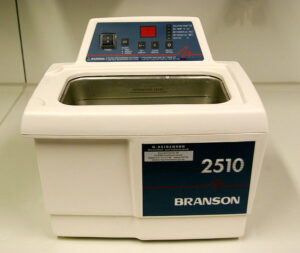
Bath sonicator device, Branson 2510 (Matylda Sękpl.wiki: Cygaretkacommons: Cygaretka / CC BY-SA (https://creativecommons.org/licenses/by-sa/3.0)
Probe Sonicator
This is a direct sonication method as a probe comes into direct contact with the sample. The energy is transmitted from the probe to the sample with high intensity. The advantage of this type is that more concentrated energy can be added to the sample compared to bath sonicator. The disadvantage of probe sonicators is the potential for sample cross-contamination and contamination by erosion of the probe tip. Probe sonicators are also not recommended for small samples.
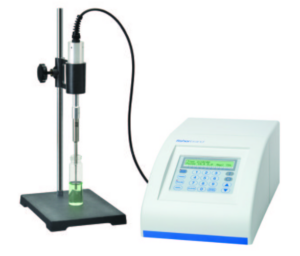
Probe Sonicator
Sonication of Alpha Synuclein Preformed Fibrils
The Michael J. Fox Foundation for Parkinson’s disease research highlights the necessity of sonication immediately before using alpha synuclein preformed fibrils in in vitro and in vivo experiments2. The length of the fibrils is critical for the pathogenicity of the aSyn PFFs as shorter fibrils are more efficient in seeding pSer129 pathology.

Schematic depiction of the protocol for generating alpha-synuclein pre-formed fibrils (aSyn PFFs) from specially formulated monomers. Stage 3 of the preparation of aSyn PFFs for use. On the day of use, an aliquot of aSyn PFFs should be thawed, diluted after the protein concentration has been re-measured, sonicated, and quality controlled prior to use. (Polinski NK, Volpicelli-Daley LA, Sortwell CE, et al. Best Practices for Generating and Using Alpha-Synuclein Pre-Formed Fibrils to Model Parkinson’s Disease in Rodents. J Parkinsons Dis. 2018;8(2):303-322. doi:10.3233/JPD-171248).
Effects of Sonication on Alpha Synuclein PFFs
Fibril size
Sonication reduces the size of the fibrils into smaller segments. Alpha synuclein fibrils with a length of 50nm or less showed significantly higher seeding activity in various experimental models, generating PD pathology5. Recommended techniques to analyze the average size of the PFFs include transmission electron microscopy (TEM), atomic force microscopy (AFM) and dynamic light scattering (DLS)2.
We sonicated our A53T alpha synuclein PFFs with a probe sonicator, increasing the amplitudes and number of pulses. Figure 1 shows that as we increase the time and power of sonication, the fibrils are slowly getting shorter (measured by TEM).
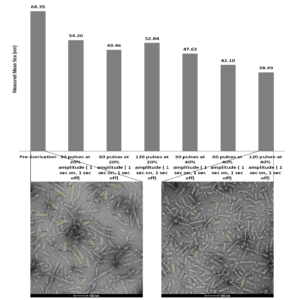
Figure 1. Increased sonication (both amplitude and number of pulses) decreases the size of A53T mutant alpha-synuclein PFFs (catalog# SPR-326). Unsonicated fibrils are longer, on average, than fibrils sonicated for 120 pulses at 40% amplitude.
Fibril Solubility
Sonication affects both fibril size and solubility. When preformed fibrils form, they are insoluble and clump together in suspension; after sonication, they move into solution and become fully soluble. This increase in solubility is another effect of sonication and it might be the reason that fibrils are more effective in experiments compared to unsonicated ones. Figure 2 shows that the unsonicated A53T fibrils are insoluble and after extended sonication they move from the pellet to the solution becoming fully soluble.
As sonication produces high temperatures, it can negatively affect fibril stability and cooling is required. This method is highly aggressive and also generates oxidative stress and free radicals which may play a role in increased solubility of alpha synuclein PFFs.
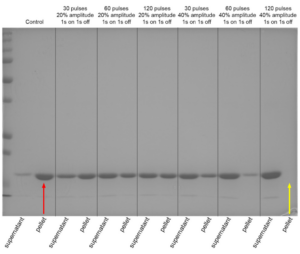
Figure 2. Sonication increases the solubility of A53T mutant alpha synuclein PFFs (SPR-326). Unsonicated fibrils are contained largely in the pellet and not the supernatant, whereas highly sonicated fibrils are contained in the supernatant and not the pellet.
Learn more about the effects of sonication on alpha synuclein preformed fibrils (PFFs) in a webinar with StressMarq President & CEO Ariel Louwrier.
REFERENCES
- Addition of exogenous α-Synuclein Pre-formed fibrils to Primary Neuronal Cultures to seed recruitment of endogenous α-Synuclein to Lewy body and Lewy Neurite-like aggregates. Volipicelli-Daley, L.A. et al. (2014) Nature Protocols 9(9):2135-2146.
- Best Practices for Generating and Using Alpha-Synuclein Pre-Formed Fibrils to Model Parkinson’s Disease in Rodents. Polinski, N.K. et al. (2018) Journal of Parkinson’s disease 8(2):303-322.
- The power of ultrasound. Santos H.M. et al. (2009) Ultrasound in Chemistry: Analytical Applications.
- Sonication of proteins causes formation of aggregates that resemble amyloid, Stathopoulos, P.B. et al. (2004) Protein Science 13(11):3017-3027.
- The Effect of Fragmented Pathogenic α-Synuclein Seeds on Prion-like Propagation. Tarutani et al. (2016) J Biol Chem. 291(36):18675-88.

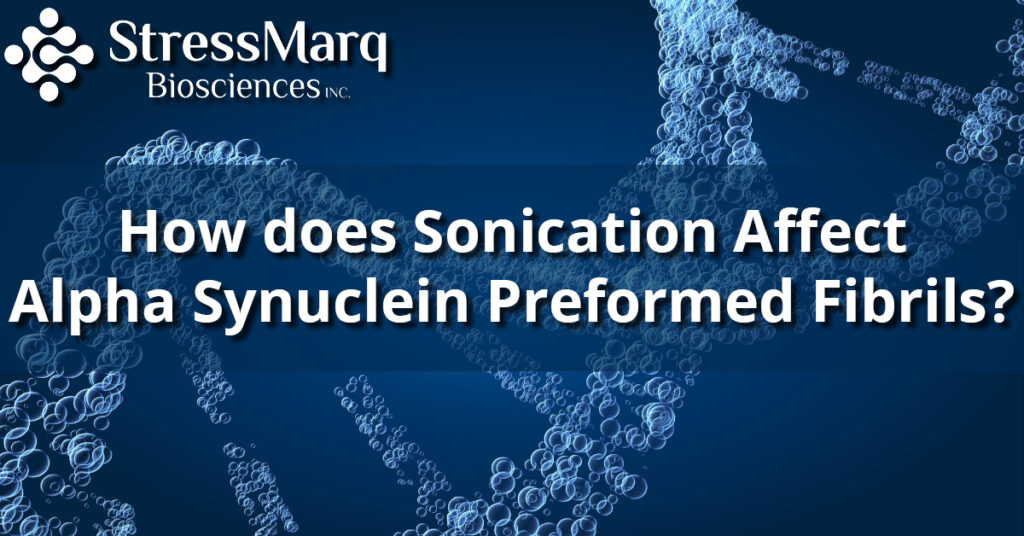
Leave a Reply